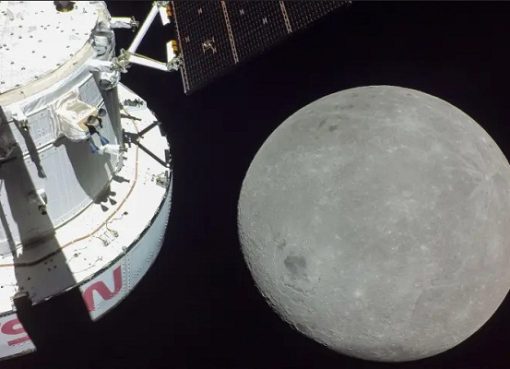As part of the Artemis mission, Nasa will conduct two multi-week field tests in the US near Flagstaff, Arizona. Meanwhile, Airbus engineers have been testing the Sample Fetch Rover (SFR) at a quarry in Milton Keynes, UK.
The Arizona desert possesses many characteristics that resemble a lunar environment, including challenging terrain, interesting geology, and minimal communications infrastructure.
The first spacecraft in Nasa’s Artemis lunar mission was scheduled to launch in August 2022. However, following the failure of two launch attempts, the take-off date has been pushed back to November 2022. The flight, which will carry mannequins rather than astronauts, would mark the next chapter in putting humans back on the Moon.
Before the Artemis-1 launch, Nasa has two test missions scheduled to take place later this month in the Arizona desert: the ‘Joint Extravehicular Activity and Human Surface Mobility Program Test Team Field Test #3’ (JETT3) and ‘Desert Research and Technology Studies (D-RATS)’.
JETT3 is expected to consist of four simulated moonwalks that follow operations planned for Artemis III, the first of the Artemis missions to land astronauts on the lunar surface. The mission will focus on providing the scientists with an understanding of the unique lighting conditions at the lunar South Pole region.
To replicate the proper lighting conditions, the JETT3 simulated moonwalks will occur at night and a simulated sun will produce lighting and shadows in the field. Two Nasa astronauts, Drew Feustel and Zena Cardman, will participate in the test.
In contrast, D-RATS will practice operations for future missions beyond Artemis III and will consist of three mission runs, in collaboration with the Japan Aerospace Exploration Agency (JAXA). The mission will primarily focus on conducting pressurised rover operations, which is a key element of future Artemis missions starting with Artemis VII in 2030.
JAXA astronauts Akihiko Hoshide and Norishige Kanai and JAXA expert Naofumi Ikeda will join Nasa astronauts Jessica Meir and Stan Love and Nasa engineer Sarah Shull in driving a pressurised rover over the course of three days, gathering data about its design, cabin configuration, driving modes and timeline constraints.

Astronaut Scott Tingle takes a closer look at rock formations at Black Point Lava Flow, Arizona during a simulated spacewalk on day 5 of NASA’s Desert Research and Technology Studies (D-RATS)
On the other side of the Atlantic, in the UK, Airbus engineers are also preparing for future Moon and Mars missions. Tests of the Sample Fetch Rover (SFR), affectionately known as Anon, have already been undertaken in Milton Keynes.
The rover was originally intended to collect sample tubes left on the surface of Mars by the Perseverance rover, but earlier this year Nasa and the European Space Agency (ESA) announced that the rover would no longer be needed for this work, as Perseverance – which landed on the Red Planet in February 2021 – is already collecting samples from the planet’s surface.
Quarry testing is essential to the development process, providing a unique and dynamic landscape that cannot be replicated within the Mars Yard test facility at Stevenage. The latest event marks the first time all the rover’s systems have been tested simultaneously.
Although it is now unlikely that the rover will ever land on Mars, scientists still believe it could be very useful in other space missions, such as those related to the Artemis programme.
“Even though the mission may have faded away, the core technology is still ready and able to go and this is the kind of the final step in proving that it works,” said Ben Dobke, project manager at Airbus. “With the Artemis programme happening at the end of the decade, the focus has started shifting towards the Moon. So any rovers or autonomous vehicles on the Moon, this software can certainly be applied to that in the future.”
In order for the rover to be used on future Moon missions, engineers will have to reconsider temperatures on the lunar surface, as well as how to keep key components functioning in the lack of atmosphere. If successful, the SFR’s technology could even be used for the purpose of building habitats on the Moon.
“There’s various avenues of investigation, so it could be scientific, going into places where there’s lunar ice,” Dobke said. “It could be in support of human habitats, whether it be autonomously building habitats or whether it’s supporting driving astronauts around on the surface. There’s a number of different applications that we could have autonomy on the Moon.”
However, a shift of focus toward Moon missions does not mean all hope is lost for the SFR visiting Mars.
Dr Adam Camilletti, space systems lead at the UK Space Agency, said: “All the technology that’s been developed for Sample Fetch Rover is still really, really useful because we’ve developed a huge amount of expertise and know-how in the UK.
“We think that can be utilised in commercial applications, for autonomous vehicles and inspecting infrastructure and down tunnels and in difficult terrains, but also we think it can be utilised in future missions, perhaps to the Moon and future missions to Mars as well.”
The UK is part of the Artemis programme, making contributions to the Lunar Gateway – a space station currently in development with the European Space Agency – working alongside the US, Europe, Canada, and Japan. The nations have together developed the Artemis Accords, a set of principles to ensure a shared understanding of safe operations, use of space resources, minimising space debris, and sharing scientific data.
Source: E&T










